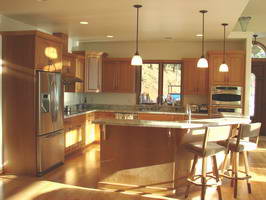Fluorescent Lighting Problems and How To Fix Them
 '; ';
|
How to Fix Fluorescent Lighting Problems: Here are the Most Common Problems with Fluorescent Lighting and How to Fix Them, How to Troubleshoot and Repair Problems with Fluorescent Lighting Fixtures. © By: Dave Rongey |
Guide to Fluorescent Light Fixtures and How to Fix Them
Electrical Repair: My Fluorescent kitchen light was not coming on quickly if at all.
- I have replaced the ballast which fixed the problem for about 3 days.
- Now it’s back to not turning on at all.
- When you hit the switch you see a flicker of light at one end of the U shaped bulbs but that is about it.
- This light has 2 U shaped fluorescent lights.
Appreciate your help !
Background: Jim, a Homeowner from Southington, Connecticut.
Additional Comments: Great website.
Dave’s Reply:
Thanks for your electrical wiring request Jim.
How to Fix Your Fluorescent Lighting Problems
Application: Troubleshooting Problems with Fluorescent Light Fixtures.
Skill Level: Beginner to Intermediate. This electrical wiring project is best performed by a Licensed Electrical Contractor.
Tools Required: Basic Hand Tools, a Voltage Tester and Safe Ladder.
Estimated Time: Depends on personal experience, the light fixture and access to the light fixture.
Precaution: Identify the light fixture circuit, turn it OFF and Tag it with a Note before working with the wiring.
Notice: Replacement parts for the light fixture should be compatible with the type of fluorescent lamps that have been installed.
The Most Common Problems with Fluorescent Lighting and How to Fix Them

If you allow the lamps to burn out in the sockets this can burn out the ballast.
- Bad Lamps
- Indicated by dark circles at the end of the lamps.
- Simply replace the lamps, typically every two years depending on the amount of use.
- If you allow the lamps to burn out in the sockets this can burn out the ballast.
- When you replace a ballast always replace all of the lamps and start fresh.
- Lamps are much less expensive that a ballast, and besides, you don’t have to worry about lamps for a while.
- A Bad Ballast
- As indicated above, if replacing a ballast make sure it is intended for the exact lamps that are being used.
- If the fixture had an older magnetic ballast then you may consider upgrading the fixture ballast to a solid state ballast.
- In most cases the sockets will not require changing, but again, you will need to match the lamps to the ballast.
- Solid state ballasts are much more energy efficient, produce less heat and are less sensitive to cool temperature starting problems.
- Single Pinned Lamps
- This is where one of the lamp pins is not in the socket or not making contact in the socket.
- This is a very common problem, but is easily fixed.
- Remove the lamp and reinstall it paying attention to lining up the pins with the lamp socket and then giving the lamp a twist to seat the pins into place.
- Some sockets are made to push the lamp pins directly into place with a little snap-in pressure.
- Examine the lamp sockets to see which type your fixture has. Never force a lamp.
- No Ground Wire
- Fluorescent lights require a ground wire from the electrical circuit to be attached to the metal frame of the light fixture, and the grounded metal reflector must be mounted within 1/2 inch of the lamps.
- In some cases where the ground wire has not been attached correctly, the fluorescent lamps may not light up at all, or the lamps will burn dimly, and this will cause the lamps to burn out prematurely.
- Cold Temperatures
- Many of the older magnetic types of ballasts are slower to start in colder temperatures and after they do start the lamps flicker until they warm up.
- For Example: The earlier non-electronic magnetic type ballasts have a minimum starting temperature of between 50 to 60 degrees Fahrenheit for the T12 F40 lamps, however the newer electronic type ballasts have a minimum starting temperature of 0 degrees Fahrenheit for T8 F32 lamps.
- As you can see, in colder applications it would be best to upgrade the light fixture to an electronic ballast and install new lamps which will eliminate the problems associated with cold temperature.
See more about Installing Home Lighting
How to Install Kitchen Electrical Wiring

Kitchen Electrical Wiring
Fully Explained Photos and Wiring Diagrams for Kitchen Electrical Wiring with Code Requirements for most new or remodel projects.
Using Testers to Identify Electrical Problems
Testers to Help Solve Electrical Problems
Troubleshooting Electrical Wiring
Types of Electrical Testers
Circuit Breakers for Light Fixture Circuits
Electrical Codes for Lighting Fixtures
The following may also be helpful for you:
|
|
Be Careful and Be Safe - Never Work on Energized Circuits!
Consult your Local Building Department about Permits and Inspections for all Electric Wiring Projects.
More articles about Fluorescent and Home Electrical Wiring: |
|
| « Previous | Next » |
Wiring a Switch to Battery Power Sources |
How to Activate a Garage Light from the Garage Door Opener |














